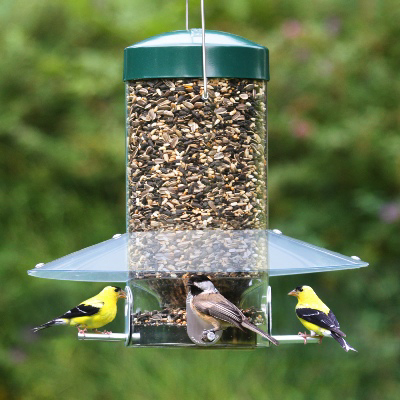
Is your seed mix attracting all the right birds this fall? It’s a good time to give seed selection a closer look as winter weather approaches.
|
You have probably done some of your own research into what seeds the birds in your neighborhood prefer, including your favorite species and all the rest. These days, many larger cities have “wild bird stores” where we can get expert advice and purchase a variety of seed options. Even some large hardware stores and department stores stock a surprising variety of seed mixes to choose from, but it’s always worthwhile to do a little comparison shopping – comparing weights and prices of packaged seed mixes – along with a little “field” research at your feeding station.
Many birders concentrate their offerings on two primary seeds – black oil sunflower seeds and thistle seeds (sometimes marketed as nyjer seeds). It is no coincidence that these two types of seeds have the highest oil and food value content, which is why birds prefer them when they are available. The small size of thistle seeds dictates that smaller birds prefer them, especially goldfinches and other winter finches. Other seed-eating birds, prefer sunflower seeds; although finches also relish sunflower “chips” that have been cut into smaller pieces to provide food for small and large seed eaters.
Shelled Options
The nice thing about sunflower chips is that they have been shelled, hence there is the no waste factor, and no messy shells that eventually cover the ground and pile up until you get out a shovel and broom to clean up. With shelled seeds, there is no mess, no clean-up, and no waste – it all gets eaten. At first it may seem that a bag of shelled seeds is a bit pricey, but you must remember that you won’t be paying for the useless shells, and you’re gaining a mess-free feeding station.
We think the ultimate seed option is a mix of shelled seeds that include whole sunflower seeds, sunflower chips, some safflower seeds, and mixed chopped nuts including peanuts. We even mix in a little thistle into that mix to entice finches to try the other options, and they quickly opt for sunflower chips. That’s a very good example of a quality shell-less seed mix that attracts a quality collection of birds to your primary feeder – cardinals, finches, grosbeaks, nuthatches, woodpeckers, jays, buntings, native sparrows, and juncos. Combine that seed mix with suet and thistle seed in their separate feeders, and you have the ultimate bird feeding options for fall, winter, and spring avian visitors.
Special Store Mixes
Some wild bird stores offer the option of making your own seed mixes, including shelled seed mixes. But these stores also offer their own mixes that are well worth trying. Plus they offer some specialty foods that can be helpful to use at times, or all the time. For instance, Wild Birds Unlimited offers a couple hot pepper treated shelled seed options that birds like but literally repels squirrels and other small mammals when they are a problem. These include Fiery Feist, a blend of sunflower chips, chopped tree nuts, and peanuts treated with hot pepper, as are the hot SunFire Chips composed solely of shelled sunflower seed chips.
The best mixes have a combination of the above seeds and nuts, and many advanced birders avoid secondary seeds altogether, including millet, red milo, and cracked corn. Overall, it’s a good idea to read the ingredient lists on seed packages, inspect the seed mix through the clear packaging, and stick to quality bird seeds and seed mixes. And the bottom line is that you should feed the seeds preferred by the birds you want to attract and observe. Enjoy feeding birds, seeing what birds you can attract and, ultimately, which birds you enjoy most. With new species arriving each week as fall migration continues, and ever more birds benefitting from your feeding station efforts – enjoy the season!
Species Seed Preferences
To learn more about the seed preferences of 15 common feeder species, you can refer to a very informative and helpful table prepared by Project Wildbird, a research study conducted continent-wide in the United States and Canada, at http://www.ectownusa.net/wbfi/docs/ProjWildbird_Research_2011_NA_numbers.pdf
Share your backyard birding experiences and photos at editorstbw2@gmail.com